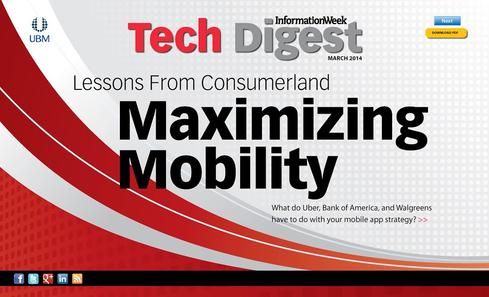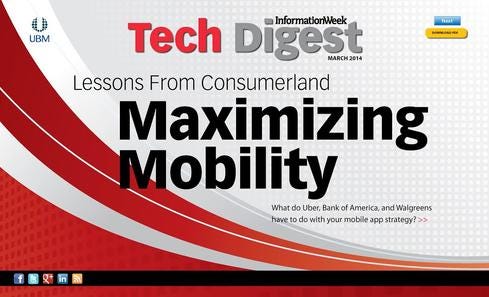Winning Mobile Strategies: Think Like A Customer
What do Uber, Bank of America, and Walgreens have in common? All win over customers with mobile app strategies that acknowledge what's convenient on a phone -- and what isn't.

 Read the whole story in the new InformationWeek Tech Digest issue (free registration required).
Read the whole story in the new InformationWeek Tech Digest issue (free registration required).
Your mobile app strategy is no place to play small ball. Yes, there's some irrational exuberance around mobility, but today's hype is often tomorrow's competitive advantage. Thinking big about mobile apps involves more than just creating responsive code and compensating for screen size. You -- or your employees -- are paying for powerful devices with 5-megapixel cameras, location capabilities, always-on 4G radios, and other advanced hardware features. Programmers should use every bit of that power to deliver convenience. If you're not, you can bet a competitor will.
In fact, don't be surprised if that technically astute board member asks about your mobile plans, much as he did five years ago about virtualization, and last year about big data. The IT executives responding to our 2014 InformationWeek Strategic CIO Survey place mobile apps at No. 3 among nine platforms considered important in building closer ties with customers, behind only development of Web applications and analysis of interaction data.
Consumer-oriented companies are leveraging smartphone hardware to allow painless access to services, and enterprise IT can find plenty of inspiration.
Snap the code
Like many retailers, Walgreens jumped in fast with iPhone, Android, and Windows Phone apps. Also like many retailers, its early versions missed the mark. The pharmacy chain's idea: Let users refill prescriptions and access other services from their phones. So far, so good. But the original app had a laborious login process and required customers to enter prescription numbers on the phone's keypad. That data entry negated the convenience benefit. Walgreens' answer was to let the customer use his or her phone's camera to snap a picture of the bar code printed on the prescription label and then submit a refill order, all from the app. Refill allowances are already in Walgreens' system, so there's no need for a formal login. Doing away with that login process greatly improved the app's acceptance. The company went on to add a chat app that lets customers consult a pharmacy professional.
Walgreens isn't the only company using cameras to cut down on error-prone data entry. Bank of America lets customers make deposits by snapping pictures of the fronts and backs of checks -- no need to visit a branch or an ATM. The app also lets customers pay bills and make transfers, so it requires a full login process. This is, after all, your money we're talking about.
Cameras can do more than photograph labels and checks. Azumio's Instant Heart Rate app makes use of cameras to detect the pulse from a user's fingertip. Pelican Imaging is working to get depth-sensing cameras in devices that will allow 3D printing and measuring the distance between two points.
It's not just cameras enabling services that wouldn't otherwise be possible. In some industries, location services are a disruptive force.
Hail the app
If you own a cab company, chances are your world has turned upside down over the past few years. First came apps that let users hail cabs from their phones and pay from a pre-authorized credit card. For customers, the advantage is substantial -- companies like Flywheel (formerly Cabulous) find the closest cab among participating companies, and payments are handled without the variability of cab drivers' perpetually malfunctioning credit card systems.
The advantage for cab companies is less clear. It's essentially this: Participate or lose the growing number of customers who want to do business this way. No doubt the industry was ripe for disruption. Rude drivers, endless waits, and dirty or unsafe vehicles will no longer fly in a world where apps provide a continuous stream of competitive data.
The latest disruption has come from Uber and Lyft, which allow freelance drivers to use their own cars and set their own hours. Although much has been written about getting hit with shockingly high Uber fares -- you don't see the final tab until after your ride -- the cost of an Uber trip is usually the same as or less than that of a licensed taxi.
But the real magic is in the app. Using location services, the Uber app shows the cars available in a given area and provides a fairly accurate estimate of pickup time. No more standing at the curb not knowing whether a cab will be dispatched in two minutes or 20. In major cities, the wait time is typically less than five minutes. Customers can enter credit card information and set tips, as well as rate drivers. Uber's had the effect of making taxi service much more like higher-priced car services, which normally must be scheduled well in advance. Uber is now gunning for that high-end market, too, with Uber Black.
The ability for customers to assess drivers (highly rated drivers get first crack at accepting fares) and for providers to set their own hours changes the employment equation. Drivers who take captive fares on white-knuckle rides -- read: employees providing bad customer service -- can't hide in an app-ified world.
La Quinta also uses location info in an app that lets travelers find its hotel properties nearby, get directions, and hold a room for four hours without entering credit card data. Travelers no longer need to juggle phone, plastic, and baggage. The app is usable via mobile browser as well. Although La Quinta might lose out by holding a room without a credit card, so far the bet has paid off.
As these examples demonstrate, the path to a successful mobile app involves a full rethink of the task at hand. Keep user convenience top of mind. Even if your audience is captive, you have a chance to delight employees and customers by starting from their point of view, not IT's. Programmers stuck in a UI world limited to screen, keyboard, and mouse must change to a degree never before seen, way beyond when vendors added speakers, microphones, and cameras to the typical laptop.
Heavy reliance on the keyboard is the first habit to kick when building mobile apps. Where free-form data entry must occur, make users type information only once. It's the app's job to remember it for future use.
Read the whole story in the new
InformationWeek Tech Digest issue (free registration required).
Too many companies treat digital and mobile strategies as pet projects. Here are four ideas to shake up your company. Also in the Digital Disruption issue of InformationWeek: Six enduring truths about selecting enterprise software. (Free registration required.)
About the Author(s)
You May Also Like
How to Amplify DevOps with DevSecOps
May 22, 2024Generative AI: Use Cases and Risks in 2024
May 29, 2024Smart Service Management
June 4, 2024







